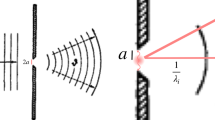Summary
Reasons for seeking to remove the space-time variables from the axioms of physical theory are presented, together with vague glimmerings on how this might be done.
Riassunto
Si espongono le ragioni per cui si dovrebbe cercare di eliminare le variabili spaziotemporali dalle teorie fisiche, e si dànno anche delle vaghe indicazioni sul modo in cui questo potrebbe esser fatto.
Similar content being viewed by others
References
G. Chew:The Dubious Role of the Space-Time Continuum in Subatomic Physics, UCRL-10891 (1963).
A. Einstein:Meaning or Relativity (Princeton, 1953) (4-th ed.).
For the remarks to be made, it is unimportant that one can make clocks out of rulers or vice versa. One can trifle about the role of solids: use a vibrating drop for clock and an optical arrangement of drops as clocks, mirrors, and lenses for ruler, but a liquid is hardly different from a solid for the present purpose, and really solids in some sense cannot be so easily avoided if we also imagine our experiments to contain observers (3).
E. Schrödinger:What Is Life 1 (Cambridge, 1945).
The following is as taught 10 years ago, byN. Kroll.
B. T. Darling:Phys. Rev.,80, 460 (1950);R. V. L. Hartley:Bell System Technical Journ.,29, 350 (1950).
E. Lubkin:A Critique of the Superposition Principle, Brown University lecture notes (1962).
J. von Neumann:Mathematical Foundations of Quantum Mechanics, tr.R. T. Beyer (Princeton, 1955).
H. Everett III:Rev. Mod. Phys.,29, 454 (1957).
An old remark ofP. A. M. Dirac, cast in modern language.Dirac said that « quantum jumps » could be the sole source of randomness; this was pointed out to me byH. Stapp.
J. A. Wheeler:Geometrodynamics (New York, 1962).
H. Poincaré:Science and Hypothesis, tr., (New York, 1952), Chapters IV and V. The principal theme of distinguishing the axiomatic geometry of mathematics from the results of physical experiments is now so familiar as to appear trivial, but note especially the following: a quote from p. 61,If, then, there were no solid bodies in nature there would be no geometry; the section entitledThe World of Four Dimensions, p. 68, and theSupplement, p. 84.
E. Lubkin:Ann. Phys. N. Y.,23, 223 (1963).
Author information
Authors and Affiliations
Additional information
This work was supported by the U. S. Atomic Energy Commission under Contract AT(30-1)-2262.
Rights and permissions
About this article
Cite this article
Lubkin, E. A critique of the space-time variables in physical theory. Nuovo Cim 32, 171–179 (1964). https://doi.org/10.1007/BF02732601
Received:
Published:
Issue Date:
DOI: https://doi.org/10.1007/BF02732601




